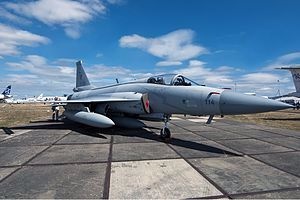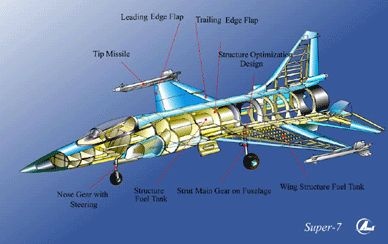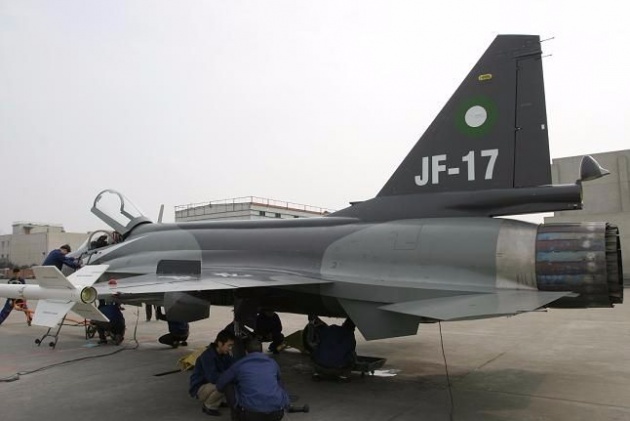JF-17 Thunder
The PAC JF-17 Thunder (Urdu: جے ایف-١٧ گرج), or CAC FC-1 Xiaolong (Fierce Dragon; Chinese: 枭龙; pinyin: Xiāo Lóng), is a lightweight, single-engine, multi-role combat aircraft developed jointly by the Pakistan Aeronautical Complex (PAC) and the Chengdu Aircraft Corporation (CAC) of China. The JF-17 can be used for aerial reconnaissance, ground attack andaircraft interception. Its designation "JF-17" by Pakistan is short for "Joint Fighter-17", while the designation and name "FC-1 Xiaolong" by China means "Fighter China-1 Fierce Dragon".
The JF-17 can deploy diverse ordnance, including air-to-air and air-to-surface missiles, and a 23 mm GSh-23-2 twin-barrelautocannon. Powered by a Guizhou WS-13 or RD-93 afterburning turbofan it has a top speed of Mach 1.6.The JF-17 is to become the backbone of the Pakistan Air Force (PAF), complementing the General Dynamics F-16 Fighting Falcon whose performance it roughly matches, at half the cost.The PAF inducted its first JF-17 squadron in February 2010 and five years later 54 units were in service, and 96 units were on order, to be delivered by the end of 2018.

The JF-17 was primarily developed to meet the PAF's requirement for an affordable, modern, multi-role combat aircraft as a replacement for its large fleet of Dassault Mirage III/5 fighters, Nanchang A-5 bombers, and Chengdu F-7 interceptors, with a cost of US$500 million, divided equally between China and Pakistan.[5] The aircraft was also intended to have export potential as a cost-effective and competitive alternative to more expensive Western fighters.The development of this aircraft was headed by Yang Wei (aircraft designer), who is considered China's "ace designer". Wei also designed the Chengdu J-20.
By 1989, because of economic sanctions by the US, Pakistan had abandoned Project Sabre II, a design study involving US aircraft manufacturer Grumman and China, and had decided to redesign and upgrade the Chengdu F-7. In the same year, China and Grumman started a new design study to develop the Super 7, another redesigned Chengdu F-7. Grumman left the project when sanctions were placed on China following the political fallout from the 1989 Tiananmen Square protests. After Grumman left the Chengdu Super 7 project, the Fighter China project was launched in 1991. In 1995, Pakistan and China signed a memorandum of understanding (MoU) for joint design and development of a new fighter, and over the next few years worked out the project details. In June 1995, Mikoyan had joined the project to provide "design support", this also involved the secondment of several engineers by CAC.

In October 1995, Pakistan was reportedly to select a Western company by the end of the year to provide and integrate the FC-1's avionics, which was expected to go into production by 1999. The avionics were said to include radar, Inertial navigation system, Head-up display, and Multi-function displays. Competing bids came from Thomson-CSFwith a variant of the Radar Doppler Multitarget (RDY), SAGEM with a similar avionics package to those used in the ROSE upgrade project, and Marconi Electronic Systems with its Blue Hawk radar. FIAR's (now SELEX Galileo) Grifo S7 radar was expected to be selected due to the company's ties with the PAF. In February 1998, Pakistan and China signed a letter of intent covering airframe development. Russia's Klimov offered a variant of the RD-33 turbofan engine to power the fighter. In April 1999, South Africa's Deneloffered to arm the Super 7 with the T-darter beyond-visual-range (BVR) air-to-air missile (AAM), rather than the previously reported R-Darter. Previously in 1987, Pratt & Whitney offered the Super-7 project three engine options; PW1212, F404, and PW1216, with local manufacturing in either China or Pakistan. Rolls Royce offered its RB199-127/128 turbofan engine; this plan was scrapped in 1989.
In June 1999, the contract to jointly develop and produce the Chengdu FC-1/Super 7 was signed. The project was to be a 50:50 partnership; the air forces of both countries would be committed to ordering the fighter. After GEC-Marconi had abandoned the bidding to supply an integrated avionics suite, FIAR and Thomson-CSF proposed a number of avionics suites based on the Grifo S7 and RC400 radars respectively, despite previously hoping to use the PAF's Super 7 to launch its new Blue Hawk radar. Because of sanctions placed on Pakistan after the country's 1998 nuclear weapons tests, design work progressed very slowly over the next 18 months, preventing delivery of the Western avionics to the PAF. In early 2001, the PAF decided to decouple the airframe from the avionics, enabling design work on the aircraft to continue. As the airframe was developed, any new avionics requirements by the PAF could be more easily integrated into the airframe.
Prototype production began in September 2002; a full-size mock-up of the FC-1/Super 7 was displayed at Airshow China in November 2002. The first batch of Klimov RD-93turbofan engines that would power the prototypes was also delivered in 2002. According to a China National Aero-Technology Import & Export Corporation (CATIC) official, the JF-17's low cost is due to some of the on-board systems having been adapted from those of the Chengdu J-10. The official said, "This transfer of technology—transposing the aircraft systems from the J-10 to the JF-17—is what makes the JF-17 so cost-effective". The use of computer-aided design software shortened the design phase of the JF-17.
The first prototype, PT-01, was rolled out on 31 May 2003; it was transferred to the Chengdu Flight Test Centre by June 2003 to be prepared for the maiden flight.This was initially planned to take place in June, but was delayed due to concerns about the SARS outbreak. The designation Super-7 was replaced by "JF-17" (Joint Fighter-17) around this point.Low speed taxiing trials began at Wenjiang Airport, Chengdu, on 27 June 2003. The maiden flight was made in late August 2003; an official maiden flight of the prototype took place in early September. The prototype was marked with the new PAF designation JF-17. By March 2004, CAC had made around 20 test flights of the first prototype. On 7 April 2004, PAF test pilots Rashid Habib and Mohammad Ehsan ul-Haq flew PT-01 for the first time. The maiden flight of the third prototype, PT-03, took place on 9 April 2004. In March 2004, Pakistan was planning to induct around 200 aircraft.
Following the third prototype, several design improvements were developed and incorporated into further aircraft. Because of excessive smoke emissions by the RD-93 engine, the air intakes were widened. Reported control problems found in testing resulted in alterations to the wing leading edge root extensions (LERX). The vertical tail fin was enlarged to house an expanded electronic warfare equipment bay in the tip. The redesigned aircraft had a slightly increased maximum take-off weight and incorporated an increased quantity of Chinese-sourced avionics; however PAF had selected Western avionics for their aircraft, postponing PAF deliveries from late 2005 until 2007. Pakistan evaluated British, French, and Italian avionics suites, the winner of which was expected to be finalised in 2006.[31] PT-04, the fourth prototype and the first to incorporate the design changes, was rolled out in April 2006 and made its first flight on 28 April 2006.
The modified air intakes replaced conventional intake ramps—whose function is to divert turbulent boundary layer airflow away from the inlet and prevent it entering the engine—with a diverterless supersonic inlet (DSI) design.The DSI uses a combination of forward-swept inlet cowls and a three-dimensional compression surface to divert the boundary layer airflow at high sub-sonic and supersonic speeds. According to Lockheed Martin, the DSI design prevents most of the boundary layer air from entering the engine at speeds up to two times the speed of sound, reduces weight by removing the need for complex mechanical intake mechanisms, and is stealthier than a conventional intake. In 1999, developmental work on the DSI with the aim of improving aircraft performance commenced. The JF-17 design was finalised in 2001.Multiple models underwent wind tunnel tests; it was found that the DSI reduced weight, cost, and complexity while improving performance.
For the avionics and weapons qualification phase of the flight testing, PT-04 was fitted with a fourth-generation avionics suite that incorporates sensor fusion, an electronic warfare suite, enhanced man-machine interface, Digital Electronic Engine Control (DEEC) for the RD-93 turbofan engine, FBW flight controls, day/night precision surface attack capability, and multi-mode, pulse-Doppler radar for BVR air-to-air attack capability. The sixth prototype, PT-06, made its maiden flight on 10 September 2006.Following a competition in 2008, Martin-Baker was selected over a Chinese firm for the supply of fifty PK16LE ejection seats.

On 2 March 2007, the first consignment of two small-batch-production (SBP) aircraft arrived in a dismantled state in Pakistan. They flew for the first time on 10 March 2007 and took part in a public aerial demonstration during a Pakistan Day parade on 23 March 2007. The PAF intended to induct 200 JF-17 by 2015 to replace all its Chengdu F-7, Nanchang A-5, and Dassault Mirage III/5 aircraft. In preparation for the in-flight refuelling of JF-17s, the PAF has upgraded several Mirage IIIs with IFR probes for training purposes. A dual-seat, combat-capable trainer was originally scheduled to begin flight testing in 2006; in 2009 Pakistan reportedly decided to develop the training model into a specialised attack variant.
In November 2007, the PAF and PAC conducted flight evaluations of aircraft fitted with a variant of the NRIET KLJ-10 radar developed by China's Nanjing Research Institute for Electronic Technology (NRIET), and the LETRI SD-10 active radar homing AAM. In 2005, PAC began manufacturing JF-17 components; production of sub-assemblies commenced on 22 January 2008. The PAF was to receive a further six pre-production aircraft in 2005, for a total of 8 out of an initial production run of 16 aircraft. Initial operating capability was to be achieved by the end of 2008. Final assembly of the JF-17 in Pakistan began on 30 June 2009; PAC expected to complete production of four to six aircraft that year. They planned to produce twelve aircraft in 2010 and fifteen to sixteen aircraft per year from 2011; this could increase to twenty-five aircraft per year.
Russia signed an agreement in August 2007 for reexport of 150 RD-93 engines from China to Pakistan for the JF-17. In 2008, the PAF was reportedly not fully satisfied with the RD-93 engine and that it would only power the first 50 aircraft; it was alleged that arrangements for a new engine, reportedly the Snecma M53-P2, may have been made.Mikhail Pogosyan, head of the MiG and Sukhoi design bureaus, recommended the Russian defence export agency Rosoboronexport block RD-92 engine sales to China to prevent export competition from the JF-17 against the MiG-29. At the 2010 Farnborough Airshow, the JF-17 was displayed internationally for the first time; aerial displays at the show were intended but were cancelled due to a late attendance decision as well as license and insurance costs. According to a Rosoboronexport official at the Airshow China 2010, held on November 16–21, 2005 in Zhuhai, China, Russia and China had signed a contract worth $238 million for 100 RD-93 engines with options for another 400 engines developed for the FC-1.
Pakistan negotiated with British and Italian defence firms regarding avionics and radars for the JF-17 development. Radar options include the Italian Galileo Avionica's Grifo S7, the French Thomson-CSF's RC400 (a variant of the RDY-2), and the British company SELEX Galileo's Vixen 500E active electronically scanned array (AESA) radar. In 2010, the PAF had reportedly selected ATE Aerospace Group to integrate French-built avionics and weapons systems over rival bids from Astrac, Finmeccanica and a Thales-Sagem joint venture. Fifty JF-17s were to be upgraded and an optional fifty from 2013 onwards, at a cost of up to US$1.36 billion. The RC-400 radar, MICA AAMs, and several air-to-surface weapons are believed to be in the contract. The PAF also held talks with South Africa for the supply of Denel A-darter AAMs.
In April 2010, after eighteen months of negotiations, the deal was reportedly suspended; reports cited French concerns about Pakistan's financial situation, the protection of sensitive French technology, and lobbying by the Indian government, which operates many French-built aircraft.[56][57] France wanted the PAF to purchase several Mirage 2000-9fighters from the United Arab Emirates Air Force, which would overlap with the upgraded JF-17.[58] In July 2010, the PAF's Chief of Air Staff, Air Chief Marshal Rao Qamar Suleman, said these reports were false. He said, "I have had discussions with French Government officials who have assured me that this is not the position of their government". Suleman also speculated that "someone was trying to cause mischief—to put pressure on France not to supply the avionics we want".
On 18 December 2013, production of Block 2 JF-17s began at PAC's Kamra facility. These aircraft have air-to-air refuelling capability, improved avionics, enhanced load carrying capacity, data link, and electronic warfare capabilities. Block 2 construction activity is planned to run until 2016, after which the manufacturing of further developed Block 3 aircraft is planned.
Usman Shabbir of the Pakistan Military Consortium has said that Block 3 aircraft might include AESA radar, HMD, avionics improvements, and perhaps some reworking of the airframe. On 17 June 2015, Jane's Defence Weekly confirmed this that Block 3 will have an AESA radar and will also include a helmet-mounted display (HMD) and possibly an internal infrared search and tracking (IRST) system.



